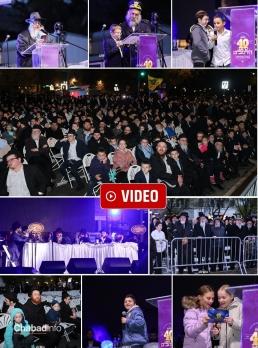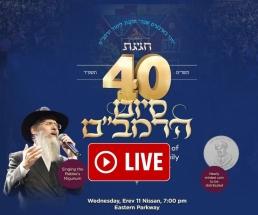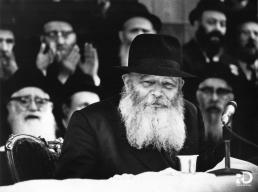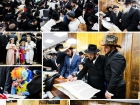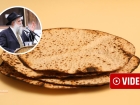Tisha B’Av 5708: Yerushalayim Under Siege
The last days before the surrender of the Jewish Quarter of Yerushalayim’s Old City in the 1948 War and the tragic death of the Lubavitcher Rav of the Kosel from Jordanian artillery fire • A Chronicle of Tears • By Beis Moshiach Magazine • Full Article
Menachem Zigelbaum, Beis Moshiach
Tisha B’Av 5708/1948 was the first Tisha B’Av that Jews were unable to pray at the Kosel, the remnant of our Beis HaMikdash, to cry over the harsh galus that, once again, mercilessly struck at the Jewish people in the form of attacks against the Jewish people; this time, not in distant Spain and not in blood-soaked Europe, but in Yerushalayim itself.
It wasn’t only the Kosel that was off-limits to Jews; other holy sites like the Churva shul, the Tzemach Tzedek shul and many other shuls in the Old City were destroyed or desolate, mourning over the Jews of the Jewish Quarter who had been exiled from their homes.
It all began several months earlier, in the winter of 5708. The British who ruled Eretz Yisrael began planning their withdrawal and the world was preoccupied with how the land would be divided between Jews and Arabs. At the same time, both sides prepared for war and who would control more territory. The war began even before the British left.
Starting in Shevat and until the beginning of Iyar, the Arabs began attacking Jews in various parts of the land. Yerushalayim was also a flash-point for many victims.
When the British left on 4 Iyar, Arab nations invaded the holy land and the attacks turned into a bitter war. The Jordanians shelled the Old City repeatedly as well as other parts of the city. The attacks were primarily against the Jewish Quarter which sustained many blows. In the course of the hostilities many civilian fighters were killed or wounded. The situation became more and more dire until the residents of the Jewish Quarter and its defenders had no choice but to capitulate. The residents left their homes and some of them were taken captive by Jordan.
There were also Lubavitcher Chassidim who lived in the city or learned there and as always, we bring the Chabad perspective to historical events. This article will focus on the sad and moving lot of Chabad Chassidim in the new and old city of Yerushalayim during the War of Independence.
PREPARED TO BE A SACRIFICE FOR THE HOLY CITY
We will begin with Rabbi Yitzchok Avigdor Orenstein and his family. He was the Rav of the Kosel and one of the directors of the Chabad yeshiva Medrash Shmuel and the director of Kollel Chabad in Eretz Yisrael.
Already during that winter, local Arabs along with Legionnaires from the Jordanian army, began attacking Jews of Yerushalayim. They directed their fire primarily against the fighters or military positions. Those in yeshivos, like talmidim in the Lubavitcher yeshiva Toras Emes, helped dig trenches and fortify houses and positions with sandbags.
Haganah fighters set up one of their positions on the roof of the Orenstein home. That was the main reason that the house became a target for the Arabs as R’ Orenstein’s daughter, Mrs. Sarah Weiss, related:
“During the shelling, my father and I were out of the Jewish Quarter. My mother and brother Avrohom (who was in charge of the position) and a few fighters were in our apartment. The northern part of the house was destroyed by an artillery shell and miraculously, nobody was killed but some were wounded, including my brother. The next day, my mother went to our house. The parts that had remained whole from the shelling the night before, were destroyed by the British army.”
The Orenstein family, having no choice, moved to live in the home of the late Av Beis Din of Yerushalayim, Rabbi Yosef Chaim Sonnenfeld zt’l, who had lived in the Battei Machseh section of the Jewish Quarter of the Old City, with his wife, Rebbetzin Chayela. After the passing of R’ Sonnenfeld, his wife moved far away, to the Diskin Orphan Home; her home remained vacant. R’ Orenstein and his wife got permission from her to live in her house, committing to leave the house as soon as they would be asked to do so.
Mrs. Weiss continues:
“My parents did not leave the Rova (Jewish Quarter), not during the difficult economic deprivation that the Jews of the Rova suffered and not during the siege of Yerushalayim.
“In the interim, my father made sure to bring residents and fighters who were killed to temporary burial, when they could not be buried on Har HaZeisim outside the Rova. Despite the practice not to bury within the city, when regular battles commenced and the number of dead mounted, it was not possible to bury them and so, in an emergency measure, it was permissible to bury the dead in a temporary grave within the Rova. The place that was chosen was a small courtyard, Rothschild’s Courtyard, near the command post of the Quarter.
“On 12 Iyar, twenty-three dead were buried in a communal grave. My father asked forgiveness of the dead and promised to move them to Har HaZeisim as soon as that would be possible. A few days later, the ceremony was repeated with another eleven dead brought to rest. This time, my father and mother were among them.”
HOW WERE RABBI AND REBBETZIN ORENSTEIN KILLED?
It was early Sunday morning, 14 Iyar, when the Jordanians began a heavy artillery barrage from the hills of Har HaZeisim in the direction of the Jewish Quarter and Battei Machseh. The Orensteins were staying in one of the houses at the far edge of Battei Machseh, the home of the Shechter family. Rabbi Yitzchok Avigdor Orenstein was woken by the shelling and he went to wash his hands. A piece of shrapnel that fell near the house hit him and he was killed on the spot.
When his wife went to check on the situation, she was also hit by shrapnel which pierced the main artery in her foot and she was gravely wounded. She died a few hours later, apparently, from loss of blood.
Thus, R’ Orenstein’s bitter prophecy, when he served as Rav of the Kosel, came true, “If it is decreed that someone be a sacrifice for the holiness of the Old City of Yerushalayim and its holy places, then I am obligated more than anyone else …”
When Rabbi Yitzchok Naeh, who ran the Chabad yeshiva Medrash Shmuel in the Tzemach Tzedek shul together with R’ Orenstein, heard the bitter news, he burst into uncontrollable tears and sat on the floor and wailed.
R’ Naeh continued running Kollel Chabad on a temporary basis. In the coming months, a letter arrived from the Rebbe Rayatz, president of the kollel, who instructed that R’ Naeh continue in his role until the forming of a new hanhala.
The day after Tisha B’Av, the Hebrew newspaper headlines cried out, “Images of the Destruction of Old Yerushalayim,” “Masses Were Taken Together with the Destroyed Kosel,” “Whoever Mourns for Yerushalayim Merits to See Its Joy,” etc.
CLASSIC WORKS WRITTEN UNDER FIRE
For many months, the Jordanians shelled Yerushalayim mercilessly. The residents were forced to spend weeks in shelters while living under difficult conditions. There was not enough food nor places to sleep and news of the wounded and dead were heard constantly which added to the difficult atmosphere.
In the midst of all this chaos and upheaval, R’ Chaim Naeh continued working on his monumental work Kuntrus HaShulchan with emendations and glosses on the Alter Rebbe’s Shulchan Aruch. Concurrently, he edited his work Shiurei Tzion in which he responds to questions to those who publicly disputed his rulings on measures in halacha. R’ Chaim Naeh lived in the Bucharim neighborhood in a shared courtyard with a two-story building that had several apartments. The Naeh family lived on the second floor. His neighbors designated a room for him on the ground floor, which was considered safer, so he could work on editing his sefarim in as secure a place as possible.
He spent most of his day on the ground floor writing his sefarim but when necessary, he would go out to the street in order to fix the neighborhood eiruv. His daughter recounts that one time, when her father went out to fix the eiruv that had been damaged by shelling, an enemy bullet passed centimeters away from him.
His house sustained a direct hit. The roof was decimated and chunks of cement and dust landed in his work room, on his sefarim, on his scale, and the furniture. Since they were in the ground floor apartment, R’ Naeh and his children saw that their lives had been miraculously saved. The repeated shelling is why the family moved to a more distant neighborhood, to the home of his brother Yitzchok, in the Zichron Moshe neighborhood.
On 10 Tammuz, there was a lull in the fighting and R’ Naeh took advantage of the opportunity. After receiving the okay from the military governor, he went to live with his daughter, Mrs. Chaya Leah Meizlish, in Petach Tikva, in order to calm down from the tremendous tension.
Then he lived with his daughter Mrs. Sarah Viged on Rechov Rav Kook 16A in Tel Aviv, near Yeshivas Achei Tmimim.
During the war, he finished editing the two works mentioned above. At the end of the forward to the Kuntrus HaShulchan, he tells about writing while under fire and the miraculous protection from Above that saved large portions of the city from those who sought to destroy it completely.
The kuntrus was sent to the Rebbe Rayatz. His son-in-law, Ramash (later the Rebbe MH”M), who saw it, sent a letter to R’ Chaim Naeh with praise as well as comments and additions.
THE LUBAVITCHER FAMILY UPROOTED FROM THE OLD CITY
The battle for the Old City heated up and the heavy price of dead and wounded went up day by day. The situation left the defenders of the Jewish Quarter with no choice but to give up.
Many combatants, citizens, including many wounded, were taken captive by the Jordanians. Some managed to get out via the Zion Gate and went to live in Katamon which had been abandoned by its Arab dwellers because of the war.
The Rabinowitz family left the Old City for Katamon: Rabbi Shmuel Benzion and his wife Mirel, distinguished Chabad Chassidim in the Old City. R’ Rabinowitz served as mashgiach in the Chabad yeshiva Medrash Shmuel and as one of the appointees of the International Tehillim Committee at the grave of Dovid HaMelech. (Years later, his grandson, named Shmuel Benzion for him, was appointed to serve as Rav of the Kosel, a job which he carries out till this day).
Due to the war, the wedding of his son R’ Nachum Rabinowitz was postponed again and again. A letter finally arrived from the Rebbe Rayatz telling him to marry soon. The wedding took place the afternoon of erev Succos 5709.
WALKING TO SHUL UNDER FIRE
The new city also sustained many losses because of the Jordanian snipers who aimed their weapons against innocent civilians. Certain streets and areas were considered dangerous when they became targets for Jordanian snipers. Among those streets was Rechov HaRav Sonnenfeld in the Beis Yisrael neighborhood, which endured repeated shooting. Unfortunately, many Jews, innocently walking down the street, were wounded or even killed.
This is why the mashpia Rabbi Yehoshua Lipkin changed his route when he walked on Shabbos from his home in Beis Yisrael to the Chabad shul in Meah Shearim. R’ Lipkin was one of the amazing personalities among the Chabad Chassidim in Yerushalayim, a model of a Chassid from earlier times.
His son, R’ Yaakov Moshe Lipkin, related:
“The Arab uprising intensified after the declaration of statehood. From where we lived in Beis Yisrael, we would always walk up Rechov Sonnenfeld toward Meah Shearim to the Chabad shul where my father davened every Shabbos. However, walking up that street became dangerous. Jews that I knew, innocently walked there and fell prey to the Jordanian snipers and wallowed in their blood. At a certain point, they spread out sandbags there to block the passersby.
“When we walked to tefillos on Shabbos in Meah Shearim, my father and I changed our route and would go up via the parallel Rechov Leib Dayan which was less exposed to the Jordanian snipers.”
On Shabbos, 13 Iyar, a shell hit the Lipkin home. It was an open miracle that nobody was hurt. The family was evacuated to the Diskin Orphan Home that became a shelter for Jews who left their homes because of the war.
After so many months of war, it was impossible to contain the great emotions that burst forth during the tefillos of the Yamim Noraim of 5709, as R’ Yaakov Moshe Lipkin relates:
“On Rosh Hashana, my father took me [a ten-year old child] from the Diskin Orphan Home to the Chabad shul in Meah Shearim. My father went up [to lead the services] at ‘HaMelech’ and was the baal tefilla for shacharis. The regular baal tefilla for mussaf, R’ Chaim Ber Chaimson, a grandson of the personal assistant of the Tzemach Tzedek, was wounded and could not go to shul. R’ Avrohom Moshe Kirschenbaum replaced him.”
MIVTZA TEFILLIN DURING THE WAR OF INDEPENDENCE
The heavy shelling of Yerushalayim did not prevent the Chassid R’ Boruch Pariz from devoting himself to Mivtza Tefillin with the people of Etzel (Irgun Tzvei Leumi, known as “the Irgun”). This was about twenty years before before the official start of Mivtza Tefillin. As his daughter, Mrs. Sarah Teichman, relates:
“Near our house on Rechov Hachavashim, Etzel had a fighting position. Hopstein, our neighbor, together with my father, would walk to the post to put tefillin on with the people of Etzel. One time, a shell landed as they were putting on tefillin. The Etzel people said to my father, ‘Don’t be afraid! Bend over and that’s that.’ It was a miracle that they weren’t hurt.”
R’ Boruch Pariz later wrote to the Rebbe Rayatz and told about the miracles that occurred to his family in the war. The Rebbe’s warm and caring response was, “Thanks to G-d for His great kindness in saving you from the dangers of war.”
*
The magazine can be obtained in stores around Crown Heights. To purchase a subscription, please go to: bmoshiach.org
270
Join ChabadInfo's News Roundup and alerts for the HOTTEST Chabad news and updates!
















